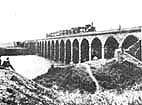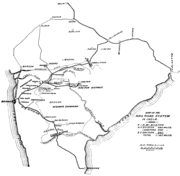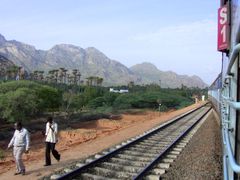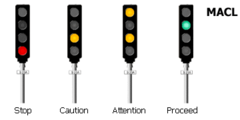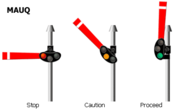Rail transport in India
2007 Schools Wikipedia Selection. Related subjects: Railway transport
- This article is about the technical workings and operations of railways in India which is run by the Indian Railways.
Rail transport is the most commonly used mode of long-distance transportation in India. Rail operations throughout the country are run by the state-owned company, Indian Railways. The rail network traverses the length and width of the country, covering a total length of 63,140 km (39,200 miles). It is one of the largest and busiest rail networks in the world, transporting over 5 billion passengers and over 350 million tonnes of freight annually. Its operations covers twenty-eight states and three Union territories and also links the neighbouring countries of Nepal, Bangladesh and Pakistan.
Railways were first introduced to India in 1853, and by 1947, the year of India's independence, they had grown to forty-two rail systems. In 1951 the systems were nationalised as one unit, to become one of the largest networks in the world.
History
A plan for a rail system in India was first put forward in 1832, but no further steps were taken for more than a decade. In 1844, the Governor-General of India Lord Hardinge allowed private entrepreneurs to set up a rail system in India. Two new railway companies were created and the East India Company was asked to assist them. Interest from a lot of investors in the UK led to the rapid creation of a rail system over the next few years. The first train in India became operational on 1851- 12-22, and was used for the hauling of construction material in Roorkee. A few years later, on 1853- 04-16, the first passenger train between Bori Bunder, Bombay and Thana covering a distance of 34 km (21 miles) was inaugurated, formally heralding the birth of railways in India.
The British government encouraged the setting up of railway companies by private investors under a scheme that would guarantee an annual return of five percent during the initial years of operation. Once completed, the company would then be transferred to the government, but the original company would retain operational control. This network had a route mileage of about 14,500 km (9,000 miles) by 1880, mostly radiating inward from the three major port cities of Bombay, Madras and Calcutta. By 1895, India had started building its own locomotives, and in 1896 sent engineers and locomotives to help build the Uganda Railways.
Soon various independent kingdoms began to have their own rail systems and the network spread to the regions that became the modern-day states of Assam, Rajasthan and Andhra Pradesh. A Railway Board was constituted in 1901, but the powers were still formally held by the Viceroy, Lord Curzon. The Railway Board operated under aegis of the Department of Commerce and Industry and had three members: a government railway official serving as chairman, a railway manager from England and an agent of one of the company railways. For the first time in its history, the Railways began to make a tidy profit. In 1907, almost all the rail companies were taken over by the government.
The following year, the first electric locomotive made its appearance. With the arrival of First World War, the railways were used to meet the needs of the British outside India. By the end of the First World War, the railways had suffered immensely, and were in a poor state. The government took over the management of the Railways and removed the link between the finances of the Railways and other governmental revenues in 1920.
The Second World War severely crippled the railways as trains were diverted to the Middle East, and the railway workshops converted into munitions workshops. At the time of independence in 1947, a big chunk of the railways went to the then newly formed Pakistan. A total of forty-two separate railway systems, including thirty-two lines owned by the former Indian princely states were amalgamated as a single unit which was christened as the Indian Railways.
The existing rail networks were abandoned in favour of zones in 1951 and a total of six zones came into being in 1952. As the economy of India improved, almost all railway production units were indigenised. By 1985, steam locomotives were phased out in favour of diesel and electric locomotives. The entire railway reservation system was streamlined with Computerisation in 1995.
Track
The total length of track used by Indian Railways is about 108,706 km (67,547 miles). Track sections are rated for speeds ranging from 75 to 160 km/h (47 to 99 mph). Indian railways uses three gauges, the Broad gauge (wider than the standard gauge – 4 ft 8½ in (1,435 mm)); the metre gauge; and the Narrow gauge (narrower than the standard gauge).
Broad gauge – 1,676 mm (5.5 ft) – is the most widely used gauge in India with 86,526 km (53,765 miles) of track. In some regions with less traffic, the metre gauge – 1,000 mm (3.28 ft) – is common, although the Unigauge project is in progress to convert all track to broad gauge. Narrow Gauge is present on a few routes, lying in hilly terrains and in some erstwhile private railways (on cost considerations), which are usually difficult to convert to broad gauge. Narrow gauge covers a total of 3,651 km (2,269 miles). The Nilgiri Mountain Railway and the Darjeeling Himalayan Railway are two famous hill lines that use narrow gauge. This gauge is also used by zoos in India, whose tracks are sometimes maintained by the railways.
Sleepers used in most places are made of prestressed concrete, steel and cast iron pots, though teak sleepers are still in use on few older lines. The prestressed concrete sleeper which is in wide use today is based on RDSO Drawing No. RDSO=T-2496. Metal sleepers were also extensively used before the advent of concrete sleepers. Indian Railways divides the country into four zones on the basis of the range of track temperature. The greatest temperature variations occur in Rajasthan, where the difference may exceed 70 ° C (158 ° F).
Locomotives
Indian Railways use a specialised classification code for identifying its locomotives. The code is usually three or four letters, followed by a digit identifying the model (either assigned chronologically or encoding the power rating of the locomotive). This could be followed by other codes for minor variations in the base model.
The three (or four) letters are, from left to right, the gauge of tracks on which the locomotive operates, the type of power source or fuel for the locomotive, and the kind of operation the locomotive can be used for. The gauge is coded as 'W' for broad gauge, 'Y' for metre gauge, 'Z' for the 762 mm narrow gauge and 'N' for the 610 mm narrow gauge. The power source code is 'D' for diesel, 'A' for AC traction, 'C' for DC traction and 'CA' for dual traction (AC/DC). The operation letter is 'G' for freight-only operation, 'P' for passenger trains-only operation, 'M' for mixed operation (both passenger and freight) and 'S' for shunting operation. A number alongside it indicates the power rating of the engine. For example '4' would indicate a power rating of above 4,000 hp (2,980 kW) but below 5,000 hp (3,730 kW). An alphabet following the number is used to give an exact rating. For instance 'A' would be an additional 100 horsepower; 'B' 200 hp and so on.
Thus,a WDM-3D is a broad-gauge, diesel-powered, mixed mode (suitable for both freight and passenger duties) and has a power rating of 3400 hp (2.5 MW).
The most common diesel engine used is the WDM-2, which entered production in 1962. This 2,600 hp (1.9 MW) locomotive was designed by Alco and manufactured by the Diesel Locomotive Works, Varanasi, and is used as a standard workhorse. It is being replaced by more modern engines, ranging in power up to 4000 hp (3 MW).
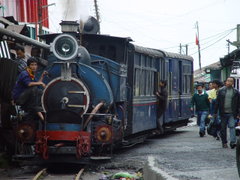
The first electric locomotives were manufactured by Indian Railways in 1970. There is a wide variety of electric locomotives used, ranging between 2800 to 6350 hp (2.1 to 4.7 MW). They also accommodate the different track voltages in use. Most electrified sections in the country use 25,000 volt AC, but railway lines around Mumbai use the older 1,500 V DC system. Thus, Mumbai and surrounding areas are the only places where one can find AC/DC dual locomotives of the WCAM and WCAG series. All other electric locomotives are pure AC ones from the WAP, WAG and WAM series. Some specialized electric multiple units on the Western Railway also use dual-power systems. These dual rakes and locomotives switch power systems on-the-fly between Virar and Vaitarna using an unelectrified section of catenary called a dead zone. There are also some very rare battery-powered locomotives, primarily used for shunting and yard work.
The only steam engines still in service in India operate on two heritage lines ( Darjeeling and Ooty) and on the tourist train Palace on Wheels. Plans are afoot to re-convert the Neral- Matheran to steam.
Traction
About 16,000 km of the total 63,028 km route length is electrified. Most places use 25,000 V AC through overhead catenary delivery. A major exception is the entire Mumbai section, which uses 1,500 V DC. This is currently undergoing change to the 25,000 V system, and is scheduled for completion by 2008. Another exception is the Kolkata Metro, which uses 750 V DC delivered through a third rail.
Traction voltages need to be changed at two places in the vicinity of Mumbai. Central Railway trains approaching through Igatpuri switch from AC to DC using a neutral section that may be switched to either voltage while the locomotives are decoupled and swapped. Western Railway trains switch power on the fly, in a section between Virar (DC) and Vaitarna (AC), where the train continues on its own momentum for about 30 m through an un-electrified dead zone. All electric engines and EMUs operating in this section are necessarily AC/DC dual system type (classified "WCAM" by Indian Railways).
Signalling systems
The Indian Railways makes use of colour signal lights, but in some remote areas of operation, the older semaphores and discs-based signalling (depending on the position or colour) are still in use. Except for some high-traffic sections around large cities and junctions, the network does not use automatic block systems. Safety therefore depends completely on the skill and vigilance of the personnel operating the individual signals and the drivers.
Coloured signalling makes use of multi-coloured lighting and in many places is automatically controlled. There are three modes:
- Two aspect signalling which makes use of a red (bottom) and green (top) lamp
- Three aspect signalling which makes use of an additional amber lamp in the centre
- Four (multiple) aspect signalling makes use of four lamps, the fourth is amber and is placed above the other three.
Multiple aspect signals, by providing several intermediate speed stages between 'clear' and 'on', allow high-speed trains sufficient time to brake safely if required. This becomes very important as train speeds rise. Without multiple-aspect signals, the stop signals have to be placed very far apart to allow sufficient braking distance and this reduces track utilization. At the same time, slower trains can also be run closer together on track with multiple aspect signals.
Semaphores make use of a mechanical arm to indicate the line condition. Several subtypes are used:
- Two aspect lower quadrant
- Three aspect modified lower quadrant
- Multiple aspect upper quadrant
- Disc-based: These signals are located close to levers used to operate points. They are all two-aspect signals.
Production units
Locomotives and coaches are produced in the following locations in India.
- CLW: The Chittaranjan Locomotive Works in Chittaranjan makes electric locomotives.
- DLW: The Diesel Locomotive Works in Varanasi makes diesel locomotives.
- ICF: The Integral Coach Factory in Perambur makes integral coaches. These have a monocoque construction, and the floor is an integral unit with the undercarriage.
- RCF: The Rail Coach Factory in Kapurthala also makes coaches for the Indian Railways.
- RWF: The Rail Wheel Factory at Yelahanka manufactures wheels and axles.
- Others: Some electric locomotives have been supplied by BHEL, and locomotive components are manufactured in several other plants around the country.
Accommodation classes
A standard passenger rake contains many coaches of different classes. The following table lists the classes in operation. Not all classes may be attached to a rake though.
| Class | Description |
|---|---|
| 1A | The First Class AC: This is the most expensive class, with fares which can be on par with airlines. Bedding is included with the fare in IR. This air conditioned coach is present only on popular routes between metropolitan cities and can carry 18 passengers. The coaches are carpeted, have sleeping accommodation and have privacy features like personal coupes. |
| 2A | AC-Two tier: Air conditioned coaches with sleeping berths, ample leg room, curtains and individual reading lamps. Berths are usually arranged in two tiers in bays of six, four across the width of the coach then the gangway then two berths longways, with curtains provided to give some privicy from those walking up and down. Bedding is included with the fare. A broad gauge coach can carry 48 passengers. |
| FC | First Class: Same as 1AC, without the air conditioning. Such coaches are not very common. |
| 3A | AC Three tier: Air conditioned coaches with sleeping berths. Berths are usually arranged as in 2AC but with three tiers across the width and two longways as before giving eight bays of eight. They are slightly less well appointed, usually no reading lights or curtained off gangways. Bedding is included with fare. It carries 64 passengers in broad gauge. |
| CC | AC Chair Car: An air-conditioned seater coach with a total of five five seats in a row used for day travel between cities. |
| EC | Executive Class Chair Car: An air-conditioned seater coach with a total of four seats in a row used for day travel between cities. |
| SL | Sleeper Class: The sleeper class is the most common coach, and usually up to ten coaches could be attached. These are regular sleeping coaches with three berths vertically stacked. In broad gauge, it carries 72 passengers per coach. |
| 2S | Seater class: same as AC Chair car, but without the air-conditioning. |
| G | General: The cheapest accommodation, with seats made of pressed wood. A seat may not be guaranteed and tickets are issued usually two hours before the scheduled departure of the train. These coaches are usually heavily crowded. |
At the rear of the train is a special compartment known as the guard's cabin. It is fitted with a transceiver and the guard usually gives the all clear signal before the train departs. A standard passenger rake generally has four general compartments, two at the front and two behind, of which one is exclusively for ladies. The exact number varies according to the demand and the route. A luggage compartment is also added to the front or the back. In some trains a separate mail compartment is present. In long-distance trains a pantry car is usually included in the centre.
Nomenclature
Trains are sorted into various categories which dictate the number of stops along their route, the priority they enjoy on the network, and the fare structure. Each express train is identified by a four-digit number – the first digit indicates the zone that operates the train, the second the division within the zone that controls the train and is responsible for its regular maintenance and cleanliness, and the last two digits are the train's serial number.
For super-fast trains, the first digit is always '2', the second digit is the zone, the third is the division and only the last digit is the serial number within the division. Trains travelling in opposite directions along the same route are usually labelled with consecutive numbers. Most express trains also have a unique name attached to them which are usually exotic and are taken from landmarks, famous people, rivers and so on. Some notable examples are:
- Charminar Express between Hyderabad and Chennai, after the Charminar monument in Hyderabad.
- Ashram Express between Ahmedabad and New Delhi, after Mahatma Gandhi's Sabarmati Ashram
- Gitanjali Express between Mumbai CST and Howrah (Kolkata), after Rabindranath Tagore's famous work.
- Parasuram Express between Mangalore and Thiruvananthapuram, after Parasuram, a mythological character.
- Prayag Raj Express between Allahabad and New Delhi, after Prayag, a sacred pilgrimage spot and the ancient name of Allahabad.
- Lal Bagh Express between Bangalore and Chennai, after the famous Lal Bagh botanical gardens.
- Godavari Express between Hyderabad and Visakhapatnam after the river Godavari in South India.
For some more Train Names (Only of South Central Railway) refer to Trains of SCR
Hierarchy of trains
Trains are classified by their average speed. A faster train has less halts than a slower one and usually caters to long-distance travel.
| Rank | Train | Description |
|---|---|---|
| 1 | Rajdhani Expresses | These are all air-conditioned trains linking major cities to New Delhi. The Rajdhani have the highest priority and are the fastest trains in India, travelling at about 140 km/h (74.5 mph). There are only a few stops on a Rajdhani route. |
| 2 | Shatabdi and Jan Shatabdi Expresses | The Shatabdi trains are AC intercity seater-type trains similar to the Rajdhani. Jan-Shatabdi trains are generally non-AC and thus cheaper. |
| 3 | Super-fast Expresses or Mail | These are trains that have an average speed greater than 55 km/h (34 mph). Tickets for these trains have an additional super-fast surcharge. |
| 4 | Express | These are the most common kind of trains in India. They have more stops than their super-fast counterparts, but they stop only at relatively important intermediate stations. |
| 5 | Passenger and Fast Passenger | These are slow trains that stop at every single station, and are the cheapest trains. The entire train consists of the General-type compartments. |
| 6 | Suburban trains | Trains that operate in urban areas, usually stop at all stations. They have the lowest priority. |
Ticketing
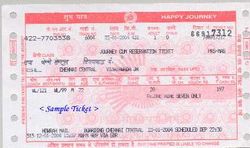
Until the late 1980s, Indian Railway ticket reservations were done manually. In late 1987, the Railways started using a computerised ticketing system. The entire ticketing system went online in 1995 to provide up to date information on status and availability. Today the ticketing network is computerised to a large extent, with the exception of some remote places. In large cities tickets can be booked for any two points in the country, which may not be available in smaller stations. Tickets can also be booked through the internet and via mobile phones, though this method carries an additional surcharge.
Discounted tickets are available for senior citizens (above sixty years) and for various other passengers including the disabled, students and high ranking government officials. Season tickets permitting unlimited travel on specific sections or specific trains for a specific time period may also be available. Foreign tourists can buy an Indrail Pass, which is modelled on the lines of the Eurail Pass, permitting unlimited travel in India for a specific time period.
For long-distance travel, reservation of a berth can be done for comfortable travel up to two months prior to the date of intended travel. Details such as the name, age and concession (if eligible) are required and are recorded on the ticket. The ticket price usually includes the base fare which depends on the classification of the train (example: super fast surcharge if the train is classified as a super-fast), the class in which one wishes to travel and the reservation charge for overnight journeys.
If a seat is not available, then the ticket is given a wait listed number; else the ticket is confirmed, and a berth number is printed on the ticket. A person receiving a wait listed ticket will have to wait until there are enough cancellations to enable him to move up the list and obtain a confirmed ticket. If his ticket is not confirmed on the day of departure, he may not board the train. Some of the tickets are assigned to the RAC or Reservation against Cancellation which is between the waiting list and the confirmed list. These allow the ticket holder to board the train and obtain an allotted seat decided by a ticket collector, after the ticket collector has ascertained that there is a vacant (absentee) seat.
Reserved Railway Tickets can also be booked through http://www.irctc.co.in, and also through Mobile Phones and SMS. More details are available at http://www.irctc.co.in. Tickets booked through this site, are categorised in to iTickets and eTickets. iTickets are those, which are booked by a passenger and then printed and delivered to the passenger for carrying during journey. eTickets are those, which the passenger can print himself at his end and carry while travelling. For booking an eTicket, one needs one of the authorised valid Photo Identity Card. Cancellation of eTickets are also done online, without the requirement for the passenger to go to any counter for this purpose.
Non-reserved tickets are available for purchase on the platform at any time before departure. A non-reserved ticket holder may only board the general compartment class. All suburban networks issue non-reserved tickets valid for a limited time period. For frequent commuters, a season pass (monthly or quarterly) guarantees unlimited travel between two stops. Suburban Season Tickets for Mumbai area can also be booked through http://www.irctc.co.in online and delivered at doorstep.
International links
India has rail links with Pakistan, Nepal and Bangladesh. It also plans to install a rail system in southern Bhutan. Before the Partition of India there were eight rail links between Indian and Pakistan. However currently there are only two actively maintained rail links between India and Pakistan. The first one is at Wagah in Punjab. The Samjhauta Express used to plies on this route from [Amritsar] in India to Lahore in Pakistan . The second one, opened in February 2006 runs between Luni – Munabao — Khokropar (MG) (Rajasthan—Sindh). Other disused links are:
- Ferozepur – Fazilka – Bahawalnagar – Samasata (through Anupgarh (India) / Amruka & Fort Abbas (Pakistan) near the border). (Punjab)
- Ferozepur — Kasur – Raiwind – Lahore (Punjab)
- Amritsar — Attari – Lahore (Punjab)
- Amritsar – Dera Baba Nanak – Narowal – Sialkot (Punjab)
- Jammu — Sialkot (Jammu and Kashmir — Punjab)
After the creation of East Pakistan (later Bangladesh), many trains that used to run between Assam and Bengal had to be rerouted through the Chicken's Neck. However as of 2005 there are no passenger links between India and Bangladesh. A MG link exists between Mahisasan (Mohishashon) and Shahbazpur. Another link is between Radhikapur and Birol. These last two links are used occasionally for freight.
- Sealdah – Bongaon – Petrapol – Benapol – Jessore
- Sealdah – Banpur – Gede – Abdulpur – Parbatipur – Haldibari – Siliguri
- Katihar – Radhikapur – Biral – Parbatipur – Tista – Eetaldaha – Golakganj – Fakiragram
- Geetaldaha – Alipur duar
- Mogalhat – Changrabandha – Domohani
- Badarpur – Kalaura (Sylhet)
There are two links between India and Nepal: Raxaul Jn., Bihar –Sirsiya, Parsa and Jaynagar, Bihar – Khajuri, Dhanusa. The former is broad gauge, while the latter is narrow gauge. A move to link the Indian and Sri Lankan railways never materialised. A ferry service however connects the closest railheads between Indian and Sri Lanka.
Private Railways
Though the Indian Railways enjoys a near monopoly in India, a few private railways do exist, left over from the days of the Raj, usually small sections on private estates, etc. There are also some railway lines owned and operated by companies for their own purposes, by plantations, sugar mills, collieries, mines, dams, harbours and ports, etc. The Bombay Port Trust ran BG railway of its own, as does the Madras Port Trust. The Calcutta Port Commission Railway is a BG railway. The Vishakhapatnam Port Trust has BG and NG (2 ft 6 in) railways.
The Bhilai Steel Plant has a BG railway network. The Tatas (a private concern) operate funicular railways at Bhira and at Bhivpuri Road (as well as the Kamshet — Shirawta Dam railway line which is not a public line). These are not common carriers, so the general public cannot travel using these. The Pipavav Rail Corporation holds a 33-year concession for building and operating a railway line from Pipavav to Surendranagar. The Kutch Railway Company, a joint venture of the Gujarat state government and private parties, is involved (along with the Kandla Port Trust and the Gujarat Adani Port) to build a Gandhidham-Palanpur railway line. These railway lines are principally used to carry freight and not for passenger traffic.
Although generally IR has decided the freight tariffs on these lines, recently (Feb 2005) there have been proposals to allow the operating companies freedom to set freight tariffs and generally run the lines without reference to IR.

